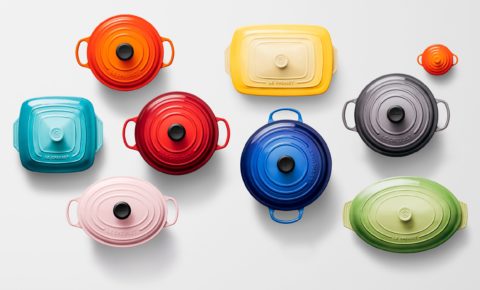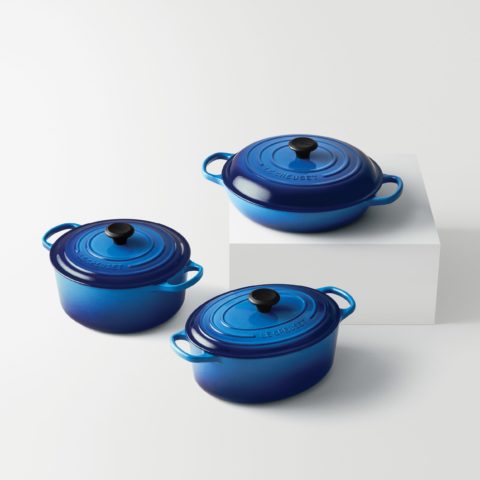Under the Lid of Le Creuset’s Iconic Cookware
Here’s how this colourful French cookware became a staple in kitchens (and hearts) across the globe.
We all have special objects in our homes that mean more to us than their everyday use: a dog-eared book, a quilt made by a grandparent or a family heirloom. These inanimate objects take on a life of their own and become an important part of our lives.
And just like those antiques passed down from generation to generation, Le Creuset cookware can withstand the test of time. It’s a source of both delicious food and fond memories. It’s not just a cast iron pot; it’s the pot your great aunt cooks her famous roast chicken in, or the vessel for your dad’s big batch of Bolognese.
Translating to “crucible,” as in a metal cauldron—or in the case of one dictionary, “melting pot”—Le Creuset holds up to its name. The enamelled cast iron cookware lasts a lifetime (or multiple lifetimes), meaning well-loved pots become part of the family. It’s beautiful, it’s sturdy and it has stories to tell.

A colourful history
After meeting at the Brussels Fair nearly a century ago, Belgian industrialists Octave Aubecq, an enamelling expert, and Armand Desaegher, a casting expert, decided to join their talents and revolutionize the cookware industry. In 1925 their first “cocotte”—or French Oven—was produced at their foundry in the Northern French village of Fresnoy-le-Grand. The original “Flame” colour was the first ever created by the brand, inspired by the intense hue of the heated molten iron that occurs early in the creation process.
Since then, Le Creuset has expanded into stainless steel and non-stick cookware, stoneware, knives and other items that are at the center of any kitchen. The company has also collaborated with designers, like Raymond Loewy, to craft unique editions over the years as well.
Colour is woven into the DNA of the brand, distinguishing their cookware from anything else on the market. Their vibrant range of colours complement and enhance any décor scheme, meaning every cook can find the perfect match for their kitchen. Colour preference is deeply personal, however, so Le Creuset advises that customers choose a colour that best captures the mood they want to set for their home, from sophisticated and serene to playful and bold.
Despite the company’s aesthetic accomplishments, its greatest innovation is the act of bringing its iconic designs to the rest of the world. What started out as a small French production turned into a beloved, world-wide kitchen staple. Sold in more than 60 countries, Le Creuset is a French heirloom that’s been passed down to the rest of us.

Cast with care
Part of what makes Le Creuset pots so iconic—and long-lasting—is the long and involved process of making them. All its cast iron products are still created in the same French village in which the brand was born. Each piece takes significant care and time to make, with at least twelve different steps taking place and fifteen skilled French artisans inspecting each item for quality assurance.
Before it gets to inspection, though, each pot starts as a piece of iron that goes into a cauldron heated to 2862°C. Next, the melted iron is individually cast in moulds made of sand, which are broken after each use, meaning that every pot is utterly unique. Small imperfections and rough edges are then removed by hand. After removing excess sand and perfecting the texture of the cast iron, the enamelling process begins. A priming clear coat is applied before a layer of coloured enamel is baked on, resulting in an extremely durable surface.

International design and inspiration
The time and care that goes into each piece is part of what makes home cooks and professionals around the world choose Le Creuset cookware, but it’s the iconic design of the brand that makes it so beloved and timeless. Over time, the shapes and styles have changed based on trends and the preferences of different regions. Japan is partial to the pastel versions, America loves bright primary colours, Canada’s best-selling hue is a rich red Cerise and France is fond of the classic Flame orange.
That might explain the 100 colour variations available around the world. Special editions are sometimes released for collaborations or holidays: a special heart-shaped cocotte was created for Valentine’s Day and a cherry-blossom-adorned version was released to celebrate 25 years of Le Creuset in Japan.
Since that first cocotte, the style of the French Oven (which differs slightly from the Dutch oven in place of origin and design) has gone through many design changes. Now considered a collector’s item, vintage Le Creuset cocottes are highly sought after by both cooks and collectors alike. A quick Google search reveals dozens of webpages where fans share their collections and discuss favourite archived designs.
The legacy of Le Creuset has lasted as long as it has partly because of its ability to adapt to the needs of the cook using it. It’s a throughway for French culture and tradition, but also, on a more personal level, for many family traditions. Maybe it’ll inspire you to finally tackle your mom’s pot roast recipe, or maybe you’ll become known in the office as the person who makes killer French bread. Either way, your Le Creuset will be there for you—and your grandkids, too.










